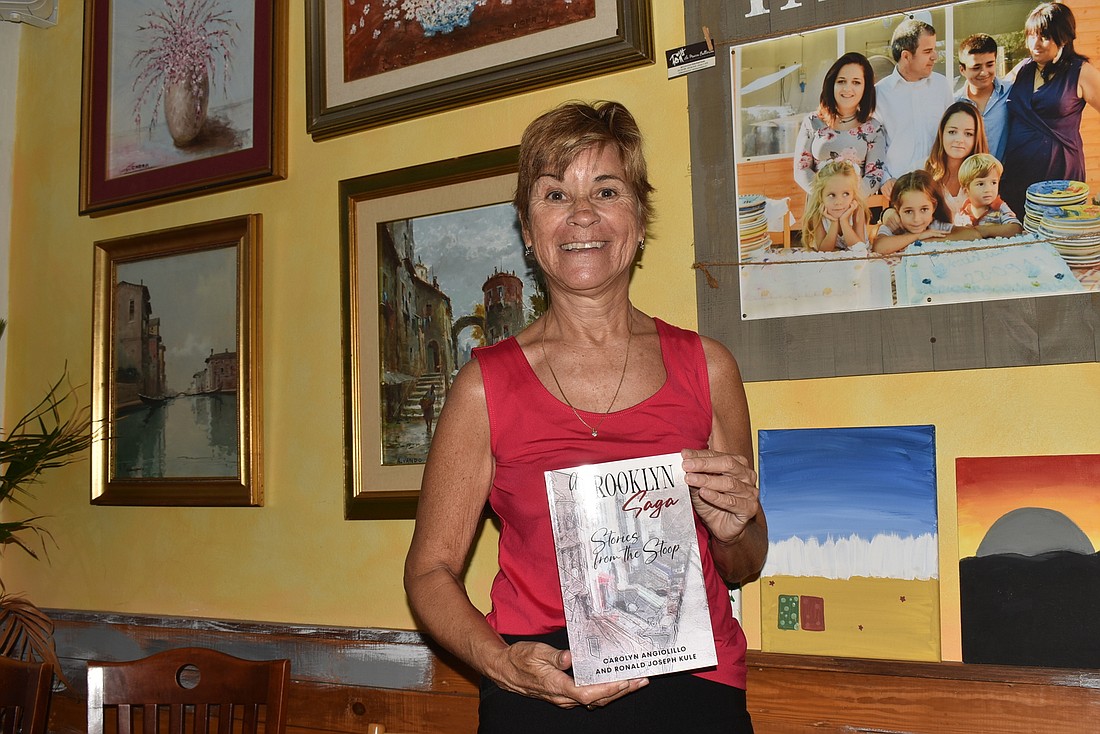- July 26, 2024
-
-
Loading

Loading

Carolyn Angiolillo has always been full of stories. Having grown up in old-world Italian Williamsburg, Brooklyn, she had plenty of scenes to re-create — the dinners every Sunday, the trips to the neighborhood stores, the Mafia incidents, the Catholic school capers. She’s been telling them to captivated friends all her life, and now, she’s written them down.
Angiolillo’s first book, “A Brooklyn Saga: Stories From the Stoop,” came out in August. She co-wrote the semi autobiographical novel with Ron Kule throughout the pandemic after giving the urgings of her friends some thought. She’d never thought much about being the actual writer, though. Angiolillo was the storyteller.
“I came from New York 14 years ago, so when I met new friends and everything, I started to talk about the stories up there,” Angiolillo said. “They were all like, ‘Wow, you should write a book.’ It was always in the back of my mind. I would always say, ‘Ooh, that would be a good story.’ I never wrote anything down.”
Though Angiolillo, now 66, retired five years ago, she kept herself busy relearning the guitar and getting back into yoga, so there was no thought of sitting down in one place to write a book. Until the pandemic hit.
“Last June … I checked on LinkedIn and I put out a proposal to find a ghost writer or a co-author or someone who writes books and I got three responses,” Angiolillo said. “When I was on the phone with the other two, I was on the phone for about 30 minutes. When I was on the phone with Ron (Kule) we were on the phone for like over two hours. He got the drift about the Italian culture, about the Italian Mafia. He just got it.”
Angiolillo spent the next few months writing stories, sending them to Kule and taking edits back. The stories got longer and longer as she kept telling them as she had to backtrack and make sure so-and-so’s background was explained, and the culture of this street got in there, and whose kids were running around. She’d written in some form her whole career, whether it was grants, proposals or programs, and her writing chops warmed up as she kept going.
The book started coming together, Angiolillo said, and chapters were switched around, chopped up and put back entirely differently.
“We started out the book with playing stoopball, because when I was a kid, I used to play stoopball,” Angiolillo said. “And we made all the characters and it looked like that was going to be chapter one, and as the months went on, it became chapter 15.”
The book is a historical fiction coming-of-age story as the main character, Angie, grows up in the vibrant Williamsburg around her. Originally called “Tacit Consent” because of the silent contract everyone in the neighborhood had to let everyone do their own thing (organized crime figures included), it became “Stories From the Stoop” because that was Angiolillo’s vantage point as a kid.
“On a Sunday, sometimes when I was a teenager, I used to sit on the stoop alone, and it was quiet on Sunday afternoons, because that was after we all had our Sunday dinner at two o'clock,” Angiolillo said. “I'd be sitting there and I'd be going, ‘I can't wait to get out of this neighborhood,’ and it was just because there was so much crap going on all the time … I used to sit there and I used to wonder what I'm going to do with my life. So when I started with the book I said, ‘I'm going to do it from sitting on the stoop. That's going to be my vantage point.’ I could see the whole neighborhood from sitting on that stoop.”
The whole neighborhood was full of fascinating, slice-of-life stories people wanted to hear, like the ones about the elaborate Sunday dinners. In Angiolillo’s world, “gravy” refers to tomato sauce and homemade meatballs were easy to come by. Williamsburg in the from the 1960s through the '70s was largely Italian, but diverse, too, and everyone lived in something of a harmony, from the gay couple to the woman who lived with two men to the "made" families.
“The other stories that I really wanted to put in were crazy stories about going to Catholic school,” Angiolillo said. “We were learning about how God's all forgiving and blah, blah, blah, and then we heard about God punishing, so you couldn't make it out. Meanwhile, the Mafia are in church, and the next day, they've beaten this guy up and thrown this one down the stairs and this guy is going to church and then later he's smacking his wife. That's pretty much what the book was, mob mentality, Catholic Church vagaries and the old world in this Italian section of Williamsburg, Brooklyn.”
Angiolillo and Kule finished the book in February and sent it to friends and family for comments. Angiolillo read it several times until she stopped catching tiny errors, and appreciated all the rigors her cohort put into the pages. The book was self-published under Carolyn Books LLC with a cover depicting Brooklyn stoops.
Once the writing was done, Angiolillo’s marketing brain kicked into overdrive. She’s scheduled book signings in Sarasota, New Jersey and New York and has posted about the book in Facebook groups about growing up in Williamsburg. She’s trying to get on TV and radio and perhaps even spark interest in a screenplay. Interest is growing in her familiar telling of 20th-century Williamsburg.
“It's funny, too, because when I started writing, I said to myself, ‘I must have grown up in the most (strange) place, but neighborhoods are like that, right?” Angiolillo said. “Because if you go to any neighborhood, even in this condo, there's so many things that happen … Every place is like its own microcosm.”